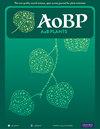春季气候条件的年际变化作为春季野花覆盖的驱动因素:一个古老温带森林的15年视角
IF 2.6
3区 生物学
Q2 ECOLOGY
引用次数: 0
摘要
春季蜉蝣是在温带落叶林中发现的野花,通常在两个月或更短的时间内显示地上的芽。早春,在冠层叶片脱落之前,标志着地上生长期的开始,在这个时期,短暂的植物通过地上组织获取营养和资源。几项研究表明,春季的短暂繁殖受到春季温度的影响,但很少有人关注当前和前一个季节的天气条件,包括降水和温度,如何影响地上的生长。在这里,我们研究了温带阔叶林春季短暂群落在其当前和以前的生长季节对天气条件的响应。15年来,我们估计了我们群落中每种物种的覆盖率。我们在这个群落中突出了5种优势的春季蜉蝣植物:野生韭菜(Allium tricoccum)、叶齿草(Cardamine concatenata)、春花(Claytonia virginica)、鼠玉米(Dicentra canadensis)和鳟鱼百合(Erythronium americanum)。我们用测量年和前一年的平均降水和温度,比较了群落和物种水平上覆盖度的变化。研究发现,降水和温度在群落和物种水平上对覆被变化有影响,但影响强度因物种而异。当年植被覆盖度与测量前30天的气温和降水之间的相关性不显著。然而,我们发现植物覆盖与前一个春季的降水和温度呈显著相关;降水量与覆被变化呈显著正相关,气温与覆被变化呈显著负相关。总的来说,更凉爽、更潮湿的春天会导致来年地上覆盖面积的增加。了解森林植物群落中的单个物种如何应对天气条件是了解植物群落如何应对气候变化的关键部分。本文章由计算机程序翻译,如有差异,请以英文原文为准。
Interannual variation in spring weather conditions as a driver of spring wildflower coverage: A 15-year perspective from an old growth temperate forest
Spring ephemerals are wildflowers found in temperate deciduous forests that typically display aboveground shoots for a period of two months or less. Early spring, before canopy leaf-out, marks the beginning of the aboveground growth period where ephemerals acquire nutrients and resources via aboveground tissues. Several studies have shown that spring ephemeral reproduction is affected by spring temperature, but few have looked at how weather conditions of the current and previous season, including precipitation and temperature, influence aboveground growth. Here we examine the response of a spring ephemeral community in a temperate hardwood forest to weather conditions during their current and previous growing seasons. For 15 years we estimated percent cover of each species within our community. We highlighted five dominant spring ephemerals within this community: wild leek (Allium tricoccum), cutleaf toothwort (Cardamine concatenata), spring beauty (Claytonia virginica), squirrel corn (Dicentra canadensis), and trout lily (Erythronium americanum). We compared changes in cover on both a community and species level from one year to the next with average precipitation and temperature of the year of measurement as well as the year prior. We found precipitation and temperature influence a change in cover at the community and species level, but the strength of that influence varies by species. There were few significant correlations between plant cover in the current year and temperature and precipitation in the 30 days preceding measurement. However, we found significant correlations between plant cover and precipitation and temperature during the previous spring; precipitation and cover change were positively correlated, while temperature and cover change were negatively correlated. Overall, cooler, wetter springs lead to an increase in aboveground cover the next year. Learning how individual species within a forest plant community respond to weather conditions is a crucial part of understanding how plant communities will respond to climate change.
求助全文
通过发布文献求助,成功后即可免费获取论文全文。
去求助
来源期刊

AoB Plants
PLANT SCIENCES-
CiteScore
4.80
自引率
0.00%
发文量
54
审稿时长
20 weeks
期刊介绍:
AoB PLANTS is an open-access, online journal that has been publishing peer-reviewed articles since 2010, with an emphasis on all aspects of environmental and evolutionary plant biology. Published by Oxford University Press, this journal is dedicated to rapid publication of research articles, reviews, commentaries and short communications. The taxonomic scope of the journal spans the full gamut of vascular and non-vascular plants, as well as other taxa that impact these organisms. AoB PLANTS provides a fast-track pathway for publishing high-quality research in an open-access environment, where papers are available online to anyone, anywhere free of charge.
 求助内容:
求助内容: 应助结果提醒方式:
应助结果提醒方式:


